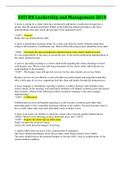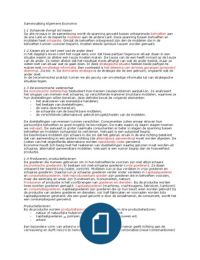HOMEOSTASIS AND ORGAN
SYSTEMS
BBS1002
Qu, Ivan (Stud. FHML)
,INHOUDSOPGAVE
Case 1: Blood and transport ............................................................................................................................. 2
Case 2: Cardiovascular system ........................................................................................................................ 11
Case 3: Blood pressure and cardiac output ..................................................................................................... 23
Case 4: Respiratory system............................................................................................................................. 31
Case 5: O2 and CO2 transport and blood pH .................................................................................................. 43
Case 6: GI tract ............................................................................................................................................... 50
Case 7: GI regulation ...................................................................................................................................... 70
Case 8: Kidneys and filtration ......................................................................................................................... 80
Case 9: Kidneys (secretion, excretion, reabsorption) and dehydration ........................................................... 91
Case 10: pH balance ..................................................................................................................................... 101
,CASE 1: BLOOD AND TRANSPORT
LEARNING GOALS
1. WHAT IS THE BLOOD COMPOSITION?
2. WHAT ARE THE BLOOD FUNCTIONS?
3. DESCRIBE THE DIFFERENCE BETWEEN VEINS, ARTERIES, AND CAPILLARIES
4. WHAT IS ACTIVE/PASSIVE TRANSPORT? WHICH FORCES DRIVE THESE PROCESSES?
→ INTERSTITIAL FLUID → COMPOSITION AND FUNCTION
5. DESCRIBE THE INTER-/INTRACELLULAR TRANSPORT MECHANISMS
RESEARCH
LEARNING GOAL 1: WHAT IS THE BLOOD COMPOSITION?
Blood is a connective tissue composed of cellular elements suspended in an extensive fluid matrix called plasma.
Plasma makes up ¼ of the extracellular fluid, the internal environment that bathes cells and acts as a buffer
between cells and the external environment. Extracellular fluid makes up 1/3 of the total body water volume and
consists of interstitial fluid and blood plasma. Blood makes up 8% of the body weight.
PLASMA: ABOUT 55% OF BLOOD VOLUME
92% → Water
7% → Proteins: synthesized by liver and secreted into the blood or
synthesized by specialized blood cells
- 60% Albumin: major contributors to plasma colloid
osmotic pressure and carriers for various substances
(produced by the liver) (protein-mediated transport)
- 36% Globulins: clotting factors, enzymes, antibodies,
and carriers for various substances
▪ Alpha and beta: produced by the liver and
most of them are carriers for lipids, metal
ions, and fat-soluble vitamins (protein
mediated transport)
▪ Gamma: antibodies released by plasma
cells
- 4% Fibrinogen: forms fibrin threads essential to blood
clotting
- Transferrin: iron transport
1% →Other
- Dissolved organic molecules: AA, glucose, lipids, nitrogenous wastes
- Ions: Na+, K+, Cl-, H+, Ca2+, HCO3- (electrolytes)
- Trace elements and vitamins
- Dissolved O2 and CO2
Plasma is identical in composition to interstitial fluid expect for the presence of plasma proteins. This makes the
osmotic pressure of the blood higher than that of the interstitial fluid. This osmotic gradient tends to pull water
, from the interstitial fluid into the capillaries and compensates filtration out of the capillaries created by blood
pressure. Plasma proteins participate in many functions: blood clotting, fighting off pathogens, carrying steroid
hormones, drugs, cholesterol, and certain ions (e.g., Fe2+) and some act as hormones or extracellular enzymes.
CELLULAR ELEMENTS OR FORMED ELEMENTS
Red blood cells (RBC, erythrocytes): 40-45% of blood volume
- Lost their nuclei before entering the blood circulation → makes the cells more malleable (passes small
cavities easier), increases the surface area for diffusion, and short life span
- Play a key role in transporting O2 from lungs to tissues and CO2 from tissues to lungs
- Can be described as bag of hemoglobins. Additionally, there are proteins that allow the RBC to be
deformed and spring back to its original state and antioxidant enzymes.
- CBC: complete blood count → a test about information of the types and number of cells in your blood,
especially the hematocrit or protein content, WBC, and platelets. With this
test, illnesses as anemia or blood clotting disorders may be diagnosed.
- Hematocrit: volume of RBC/total blood volume
→ Normal range, male 40-54% and female 37-47%
HEMOGLOBIN
Hb is made up of 4 red heme groups bound to globin, consisting of 2 alpha and 2
beta polypeptide chains. A Hb can transport up to 4 O2 molecules, as the iron atom can combine reversibly with
one molecule of oxygen (< 4 O2 is partially saturated, 4 means fully saturated). Each RBC contains about 250
million Hb molecules. Due to their presence in the RBCs, they won’t leak out of the
bloodstream and won’t increase the viscosity of the blood and thus raising the
osmotic pressure. About 20% of the CO2 transported in the blood combines with
hemoglobin, but it binds to globin’s AAs, rather than the heme group, forming
carbaminoHb.
White blood cells (WBC, leukocytes)
- When blood is centrifuged, it is between the RBC and plasma visible as the
buffy coat
- Fully functioning cells in the blood circulation
- Blood contains 5 types of mature WBCs: lymphocytes, monocytes, neutrophils, eosinophils, and
basophils. Monocytes that leave the circulation and enter in tissues develop into macrophages and
tissue basophils are called mast cells.
- Agranulocytes
o Phagocytes: neutrophils, monocytes, and macrophages (phagocytosis)
o Immunocytes/lymphocytes (specific immune responses against invaders)
- Granulocytes: basophils, eosinophils, neutrophils (cytoplasmic inclusions)
Platelets (thrombocytes)
- Cell fragments (no nuclei, not an actual cell) that split off from a megakaryocyte
- Coagulation: the process by which blood clots prevent blood loss in damaged vessels
- Platelets and WBCs make up less than 1% of the blood volume
- Hemostasis is prevention of blood loss. The steps are vascular spasm, platelet plug formation and blood
coagulation.
SYSTEMS
BBS1002
Qu, Ivan (Stud. FHML)
,INHOUDSOPGAVE
Case 1: Blood and transport ............................................................................................................................. 2
Case 2: Cardiovascular system ........................................................................................................................ 11
Case 3: Blood pressure and cardiac output ..................................................................................................... 23
Case 4: Respiratory system............................................................................................................................. 31
Case 5: O2 and CO2 transport and blood pH .................................................................................................. 43
Case 6: GI tract ............................................................................................................................................... 50
Case 7: GI regulation ...................................................................................................................................... 70
Case 8: Kidneys and filtration ......................................................................................................................... 80
Case 9: Kidneys (secretion, excretion, reabsorption) and dehydration ........................................................... 91
Case 10: pH balance ..................................................................................................................................... 101
,CASE 1: BLOOD AND TRANSPORT
LEARNING GOALS
1. WHAT IS THE BLOOD COMPOSITION?
2. WHAT ARE THE BLOOD FUNCTIONS?
3. DESCRIBE THE DIFFERENCE BETWEEN VEINS, ARTERIES, AND CAPILLARIES
4. WHAT IS ACTIVE/PASSIVE TRANSPORT? WHICH FORCES DRIVE THESE PROCESSES?
→ INTERSTITIAL FLUID → COMPOSITION AND FUNCTION
5. DESCRIBE THE INTER-/INTRACELLULAR TRANSPORT MECHANISMS
RESEARCH
LEARNING GOAL 1: WHAT IS THE BLOOD COMPOSITION?
Blood is a connective tissue composed of cellular elements suspended in an extensive fluid matrix called plasma.
Plasma makes up ¼ of the extracellular fluid, the internal environment that bathes cells and acts as a buffer
between cells and the external environment. Extracellular fluid makes up 1/3 of the total body water volume and
consists of interstitial fluid and blood plasma. Blood makes up 8% of the body weight.
PLASMA: ABOUT 55% OF BLOOD VOLUME
92% → Water
7% → Proteins: synthesized by liver and secreted into the blood or
synthesized by specialized blood cells
- 60% Albumin: major contributors to plasma colloid
osmotic pressure and carriers for various substances
(produced by the liver) (protein-mediated transport)
- 36% Globulins: clotting factors, enzymes, antibodies,
and carriers for various substances
▪ Alpha and beta: produced by the liver and
most of them are carriers for lipids, metal
ions, and fat-soluble vitamins (protein
mediated transport)
▪ Gamma: antibodies released by plasma
cells
- 4% Fibrinogen: forms fibrin threads essential to blood
clotting
- Transferrin: iron transport
1% →Other
- Dissolved organic molecules: AA, glucose, lipids, nitrogenous wastes
- Ions: Na+, K+, Cl-, H+, Ca2+, HCO3- (electrolytes)
- Trace elements and vitamins
- Dissolved O2 and CO2
Plasma is identical in composition to interstitial fluid expect for the presence of plasma proteins. This makes the
osmotic pressure of the blood higher than that of the interstitial fluid. This osmotic gradient tends to pull water
, from the interstitial fluid into the capillaries and compensates filtration out of the capillaries created by blood
pressure. Plasma proteins participate in many functions: blood clotting, fighting off pathogens, carrying steroid
hormones, drugs, cholesterol, and certain ions (e.g., Fe2+) and some act as hormones or extracellular enzymes.
CELLULAR ELEMENTS OR FORMED ELEMENTS
Red blood cells (RBC, erythrocytes): 40-45% of blood volume
- Lost their nuclei before entering the blood circulation → makes the cells more malleable (passes small
cavities easier), increases the surface area for diffusion, and short life span
- Play a key role in transporting O2 from lungs to tissues and CO2 from tissues to lungs
- Can be described as bag of hemoglobins. Additionally, there are proteins that allow the RBC to be
deformed and spring back to its original state and antioxidant enzymes.
- CBC: complete blood count → a test about information of the types and number of cells in your blood,
especially the hematocrit or protein content, WBC, and platelets. With this
test, illnesses as anemia or blood clotting disorders may be diagnosed.
- Hematocrit: volume of RBC/total blood volume
→ Normal range, male 40-54% and female 37-47%
HEMOGLOBIN
Hb is made up of 4 red heme groups bound to globin, consisting of 2 alpha and 2
beta polypeptide chains. A Hb can transport up to 4 O2 molecules, as the iron atom can combine reversibly with
one molecule of oxygen (< 4 O2 is partially saturated, 4 means fully saturated). Each RBC contains about 250
million Hb molecules. Due to their presence in the RBCs, they won’t leak out of the
bloodstream and won’t increase the viscosity of the blood and thus raising the
osmotic pressure. About 20% of the CO2 transported in the blood combines with
hemoglobin, but it binds to globin’s AAs, rather than the heme group, forming
carbaminoHb.
White blood cells (WBC, leukocytes)
- When blood is centrifuged, it is between the RBC and plasma visible as the
buffy coat
- Fully functioning cells in the blood circulation
- Blood contains 5 types of mature WBCs: lymphocytes, monocytes, neutrophils, eosinophils, and
basophils. Monocytes that leave the circulation and enter in tissues develop into macrophages and
tissue basophils are called mast cells.
- Agranulocytes
o Phagocytes: neutrophils, monocytes, and macrophages (phagocytosis)
o Immunocytes/lymphocytes (specific immune responses against invaders)
- Granulocytes: basophils, eosinophils, neutrophils (cytoplasmic inclusions)
Platelets (thrombocytes)
- Cell fragments (no nuclei, not an actual cell) that split off from a megakaryocyte
- Coagulation: the process by which blood clots prevent blood loss in damaged vessels
- Platelets and WBCs make up less than 1% of the blood volume
- Hemostasis is prevention of blood loss. The steps are vascular spasm, platelet plug formation and blood
coagulation.











